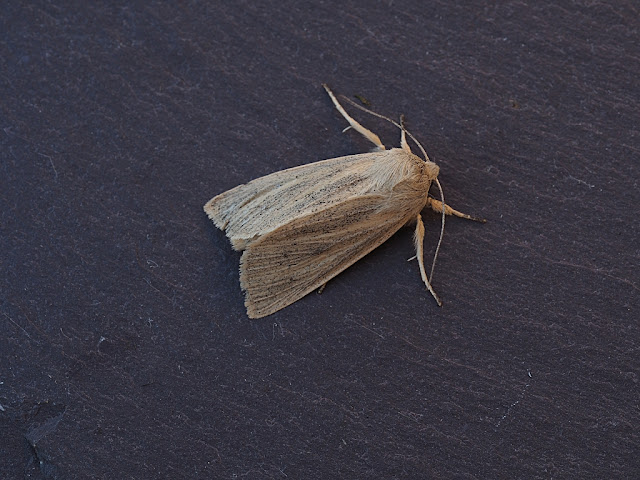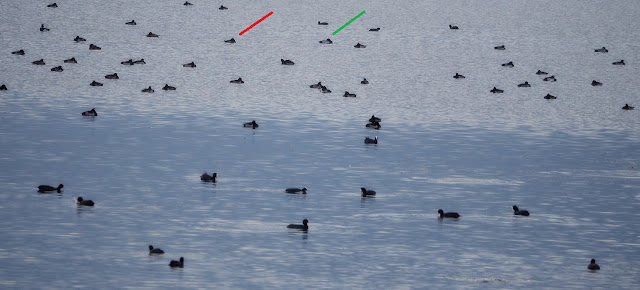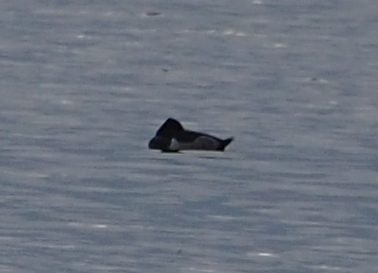Where on earth would islanders like ourselves choose to go for our second proper holiday in rather a long time? Clue, in July we went to Arran. Yes, of course, another Scottish island!
Having just retired from working in local authority education nearly continuously since 1978 the opportunity to go on holiday in late August and early September, a great time for watching migrating birds, is a real novelty. So we headed for Lewis, staying as near to The Butt as we could. I used to do a lot of seawatching and I have spent time watching at some of the most iconic seawatch sites in the UK and Ireland, Dungeness, Flamborough Head and Blananarragaun, to name three where I have spent many, many hours. Here in Orkney the prime seawatch sites are on outer isles, most notably Papay, Westray and of course, North Ronaldsay. Dennis Head, North Ronaldsay is arguably the best, or in the top three, seawatch sites in the UK. I've watched from all of these but accessibility for regular visits from West Mainland is limited by time and cost. So seawatching has become less of a thing for me and my increasing interest in invertebrates, rather than birds, has also put a constraint on my time staring out to sea in the hope that some rare thing will pass by me.
The Butt of Lewis is an under-watched place, geographically interesting and an ideal height, a perfect seawatch spot. It was Tony Marr's patch for ten years or so, https://www.outerhebridesbirds.org.uk/index.php?threads/end-of-an-era-a-thank-you-to-tony-marr.1021/ and it produced a first for the Western Palearctic, Purple Martin; well worth a visit.
 |
Don't watch from this side, the west (although it did get me a Sparrowhawk perching on offshore rocks).
|
 |
The lighthouse from the seawatch place.
|
 |
Gannets passing, there were constant streams in both directions, feeding movements.
|
The Butt did not disappoint. Fabulous seabird passage and watching, although I'm not as resilient as I used to be and a couple of hours is probably enough for me. However, I was getting out for 07:00 starts, largely, took a bit of doing!
So, what did I see? The first attempt on 29/08/2021, an hour and a half just after 08:00 included 70 European Storm Petrel, 63 Manx Shearwater and 27 Sooty Shearwater. If I'd got there an hour earlier I think I might have done much better as on 31/08/2021 in two hours starting just after 07:00 I saw 646 European Storm Petrel, 46 Manx Shearwater and 33 Sooty Shearwater, 515 ESPs were in the first hour. That watch also included the best birds of the trip, three Leach's Petrels, birds I see rarely on a seawatch, although thanks to AL I'd held one during a ringing expedition at the beginning of the month. Other good seawatch birds over the week included Arctic Skuas, Great Skuas, Arctic Terns, Common Scoter and good numbers and species variety of auks. Further seawatches contributed more sightings of these species in lower numbers but the potential of something excellent is always there.
I did do a bit of birding around South Dell, the village where we were staying, and during a tramp in the Lewis hills. We had a few encounters with both White-tailed and Golden Eagle, a flock of 70 or so Twite was nice, and Great Northern Divers on the sea.
 |
White-tailed Eagle.
|
 |
Great Northern Diver.
|
Lewis is a fabulous destination for birding in the UK. Have a look here for recent news etc - https://www.outerhebridesbirds.org.uk/index.php There is also an interesting resource which shows the current status of each species across the isles, https://status.outerhebrides-birdreports.org The county recorder is helpful and very interested in your records, put them into Birdtrack https://app.bto.org/birdtrack/login/login.jsp?s=1>l=main%2Fdata-home.jsp or email: recorder@outerhebridesbirds.org.uk
During one of our tramps down the croft to the sea and along the shore we bumped into a local crofter. "Have you seen a piglet?" I bought four and they escaped, the dog got three back but one's still missing." We offered to keep an eye out and took a phone number to call if we located the miscreant. But Louise was troubled by the meeting, "I know that man." This would seem unlikely, he was clearly Lewis born and bred, we've never been to Lewis before. Further along the way we bumped into another local. (This makes the Lewis coast seem a busy place, really you can walk for days and meet not a soul.) "Have you seen the pig?" We replied in the negative, and the questioner also mentioned he'd not seen it. Somehow the conversation came around to Louise recognising the crofter. "That's Sweeny, Donald McSween. You know, from An Lot? BBC Alba!" The penny dropped. Louise does not speak Gaelic, and the language is not spoken in Orkney but Louise rather likes BBC Alba and watches it quite often. An Lot (The Croft) is filmed in north Lewis, Sweeny is star of the show (and now we have his phone number!). Here's a link to a more serious bit of the programme https://www.bbc.co.uk/programmes/p09qcy95 but much of it is very light-hearted, entertaining, recommended.

Sweeny on the beach below the croft, no pig to be seen.
I'd taken a Heath trap with me and loaded with an actinic light, it did pretty well. We were fortunate to be staying in a rental cottage next to a well established garden with a variety of species of trees. Whilst I did some mothing before we moved to Orkney, 12 years ago, it was not very consistent and I didn't try too hard to identify things that weren't immediately obvious. So, whilst I know the moths I find in my Orkney garden and nearby I have limited experience of moths elsewhere in the UK. There were some identification struggles on this trip. Many thanks to Steve Duffield, the Western Isles CMR, and to SS for their help with IDs. Not Quite Scilly has written interestingly about identification on a number of occasions and this post, about sometimes getting things wrong, is honest, helpful and reassuring - https://notquitescilly2.blogspot.com/2021/08/identifying-birds.html A similar situation pertains to moth identification which IMHO is a lot more tricky than birds. Sounds as if I'm excusing myself in advance for some clangers, but I'll happily admit to having some struggles with the ID of the diver(s) up the page which I'd assigned to Black-throated at one point.
 |
| Clanger No1, Grey Chi (thanks SD). Through lack of care and research I'd gone for Grey Arches which is larger and an altogether less pretty Noctuid. NFM anyway, I caught quite a few of these. |
|
|
 |
Sallow, possibly NFM, I can't remember, I don't see them in Orkney
anyway. Not many records for Lewis, I also saw the other colour form as
well. I did manage to ID this one on my own.
|
 |
Northern Rustic, NFM, I also made a pig's ear of this one.
|
 |
Cloaked Minor, I did eventually get this right under my own steam but asked and received a bit of reassurance as this is a really good record for Lewis, NFM, thanks SS and SD. Coin for size as I'd mislaid my ruler.
|
 |
Grey Chi again, what a fabulous beast. And after I'd been told, I could get the ID right (hopefully...).
|
 |
These I could get in the right region as I've been shown a White-line Dart in Burray in the past. I also knew that Coast Dart is similar, possible, if rare. These were confirmed as the more plentiful White-line Dart, thanks again to SD and SS.
|
 | | | | |
| Pig's ear time again with this Neglected Rustic, NFM. |
|
 |
I didn't even attempt this rather worn Northern Deep Brown Dart but "phoned a friend", thanks SS.
|
 |
Northern Deep Brown Dart, NFM.
|
 |
Sallow, the other colour form.
|
The Sallow illustrated this quite well, the problem with identifying moths, the same species can have a variety of colour forms. The Common Rustic s.l. (an aggregate of two species that require dissection to determine their specific - s.s. identity) and Large Yellow Underwing can demonstrate this equally well. The other issue is that like birds there are no dichotomous keys to moths, you basically have to scroll through images until you find a reasonable possibility and then read the text and look at the distribution. Yes, you can get to family reasonably easily through a bit of experience but a family like Noctuidae is large and diverse. Tricky. Dichotomous keys can be a bit of a pain to use, they require time, a methodical approach and a good knowledge of physiology and physiological terms but generally, not always, with little expeience of a group of animals or plants, you can get to a fairly reliable ID under your own steam, and then "phone a friend" for final confirmation. (These days with Facebook and Twitter you may get your record confirmed by a recognised national or international expert.) Sometimes with moths and birds, until you gain quite extensive and broad experience its a case of taking a punt and hoping for the best.
There's loads more to write about Lewis, I haven't broached the moth trap intruders and other things we found and did, the body boarding pensioner, for example, but I'm going to post and continue later...













































